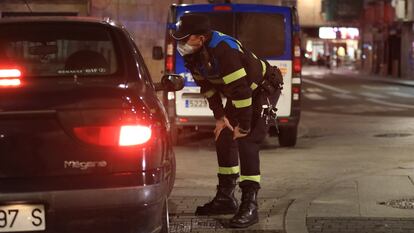Spain’s new state of alarm: what you can and can’t do
The Spanish Cabinet on Sunday approved a curfew from 11pm to 6am, leaving the regions various options when it comes to restricting mobility

Spanish Prime Minister Pedro Sánchez announced on Sunday a new state of alarm for Spain. The regional governments will be in charge of implementing the coronavirus restrictions they see fit, and under the emergency situation will now be able to limit fundamental rights such as freedom of movement without having to first turn to the courts for authorization. The decree approved by the Cabinet contains one blanket restriction: a nighttime curfew, the timing of which can be altered by the regions by one hour either way.
What does the curfew involve?
It limits all nighttime movement, apart from justified reasons such as going to work, to seek medical treatment or to take care of dependents. The government has set the timetable from 11pm to 6am, but the regions can bring it forward or backward by an hour. This measure will not be applied in the Canary Islands, the Spanish region that currently has the lowest incidence of the coronavirus. So far, the Balearics have confirmed they will follow the government’s recommendation of 11pm to 6am. The Valencia region will implement it from 12am to 6am.
Will there be perimetral lockdowns of regions or municipalities?
This will be left in the hands of the regional governments. They will now be able to confine their entire territory or other smaller zones within the same, such as provinces, municipalities or even neighborhoods. This is compatible with the confinements of basic healthcare areas, which will be introduced on Monday by the Madrid regional government, for example. On Monday, Asturias, Aragón and the Basque Country announced border closures starting this week. Andalusia and Madrid could soon follow suit.
Will there be limits on social meetings?
The state of alarm allows for the regions to limit social meetings to six people or fewer.
How long will the state of alarm last?
The Cabinet has approved it for 15 days, in line with the Constitution. But Sánchez has announced that the government is intending to extend it until May 9. To do so, it will need the approval of the Congress of Deputies. The Popular Party (PP) has already signaled that it is willing to support an eight-week state of alarm, which would end right before Christmas, but nothing longer than that. And Ciudadanos (Citizens) has also said it is ready to back the measure, but feels that six months is too long.
What is the difference between this state of alarm and the one in March?
During the first wave, the state of alarm was used to confine residents to their homes, which they could not leave except for going to work, to purchase essential items, go to the doctor and other justified activities. Restaurants, bars and stores were also closed. On this occasion, for now, none of this will be repeated. Apart from the curfew, citizens will be able to leave their homes and go to stores and restaurants, depending on the limitations that are established by each regional government.
What measures will each region take?
Spain’s regional governments and the Health Ministry agreed on Thursday on a set of criteria for action to be taken in each area. It establishes four levels – extreme, high, medium and low – that are determined by combining eight principal indicators and 20 secondary ones that measure both the incidence of the epidemic as well as the capacity of the healthcare system. There is still no official evaluation of which areas are at extreme risk. But if the barometer approved by the regions and the ministry is applied to the average indicators of the regions, seven would exceed this level: Aragón, Castilla-La Mancha, Castilla y León, Catalonia and La Rioja, as well as the North African cities of Ceuta and Melilla.
English version by Simon Hunter.
Tu suscripción se está usando en otro dispositivo
¿Quieres añadir otro usuario a tu suscripción?
Si continúas leyendo en este dispositivo, no se podrá leer en el otro.
FlechaTu suscripción se está usando en otro dispositivo y solo puedes acceder a EL PAÍS desde un dispositivo a la vez.
Si quieres compartir tu cuenta, cambia tu suscripción a la modalidad Premium, así podrás añadir otro usuario. Cada uno accederá con su propia cuenta de email, lo que os permitirá personalizar vuestra experiencia en EL PAÍS.
¿Tienes una suscripción de empresa? Accede aquí para contratar más cuentas.
En el caso de no saber quién está usando tu cuenta, te recomendamos cambiar tu contraseña aquí.
Si decides continuar compartiendo tu cuenta, este mensaje se mostrará en tu dispositivo y en el de la otra persona que está usando tu cuenta de forma indefinida, afectando a tu experiencia de lectura. Puedes consultar aquí los términos y condiciones de la suscripción digital.
More information
Últimas noticias
Petro claims the ELN was the target of US attack in Venezuela
Maduro counterattacks Trump with rhetoric and announces downing of nine drug trafficking aircraft
‘Ecce Homo’: The miraculous disaster that made a small Spanish town famous
Return to sex testing at the Olympics: IOC edges closer to banning transgender women
Most viewed
- Sinaloa Cartel war is taking its toll on Los Chapitos
- Oona Chaplin: ‘I told James Cameron that I was living in a treehouse and starting a permaculture project with a friend’
- Reinhard Genzel, Nobel laureate in physics: ‘One-minute videos will never give you the truth’
- Why the price of coffee has skyrocketed: from Brazilian plantations to specialty coffee houses
- Silver prices are going crazy: This is what’s fueling the rally










































